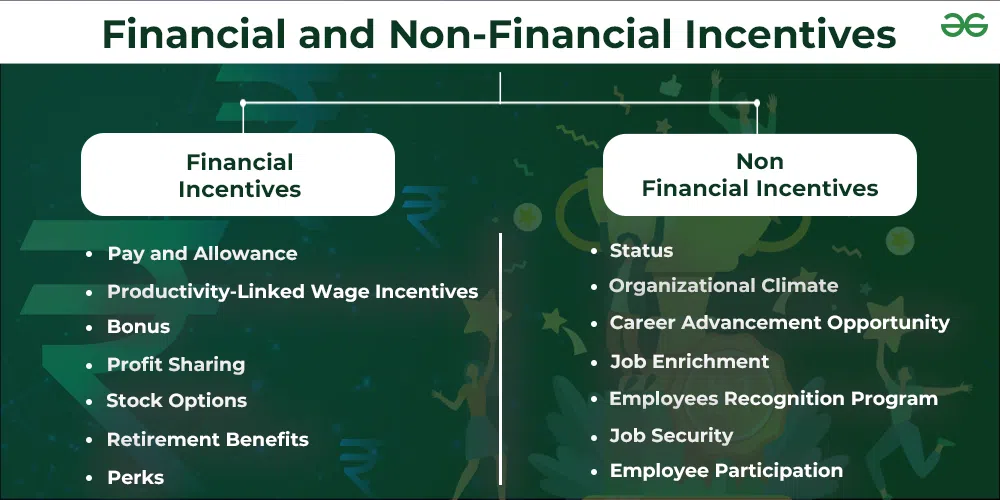Financial and Non-Financial Incentives
Last Updated :
17 Jan, 2024
Incentive refers to all majors in the form of monetary and non-monetary rewards, which are used to motivate people to improve performance. The needs of employees are different. Some of them can be satisfied by money, while others cannot be satisfied by only money. The incentives are classified into two categories or groups they are Financial incentives and Non- Financial incentives.

Financial Incentives
Financial Incentives are those incentives that can be calculated in terms of money. Money plays a great role in satisfying the needs of a person to obtain a social position and power. It not only satisfies lower level needs but also satisfies the higher level needs, such as social status, power, etc. These monetary incentives are provided to motivate people for better performance. These incentives can be provided to both individuals and groups. Some of the common financial incentives are as follows:
- Pay and allowance: Salary is the basic monetary incentive for every employee. It includes basic pay, dearness, allowances, house rents, conveyance, etc. In some business organizations, pay hikes and increments may be linked to performance.
- Productivity-linked wage incentives: Some companies have adopted wage plans according to their performance. The main aim of this incentive is to improve the productivity of the employees by paying higher wages to efficient workers compared to inefficient workers.
- Bonus: Bonus is a one-time reward offered to the employees for achieving higher performance. It is generally paid during the festival season or after achieving the target.
- Profit Sharing: Profit sharing means sharing of profit earned by a company with employees. Profit sharing is an arrangement between employees in which they are given a part of the share of profits.
- Stock options: Under this scheme, employees are given an option to purchase shares at a price less than the market price. The allotment of shares creates a feeling of awareness that he is also a part of the owner of the organization.
- Retirement benefits: Some companies offer various retirement benefits, such as pension, provident fund, gratuity, etc., for employees to motivate them towards the achievement of organizations.
- Perks: Many companies offer additional benefits other than the salary, known as perks. Examples, medical facilities, free education for the children of the employees, free housing facilities, etc.
Non-Financial Incentives
Non-financial incentives refer to incentives or rewards which cannot be measured in terms of money. All the needs of individuals are not satisfied by money only. Psychological, social, and emotional factors also play an important role in providing motivation. Some of the common non-financial incentives are:
- Status: Status refers to reducing the position and prestige associated with a job in the organization. Higher status helps to satisfy safety and social need, esteem needs, and self-actualization needs. Management provides status symbol facilities to its employees to motivate them. For example, costly furniture, well-furnished AC cabins, a car, etc.
- Organizational climate: It refers to the characteristics which describe an organization and distinguish one organization from the other. Characteristics include individual autonomy, reward orientation, open communication, etc., which directly influence individual behaviour in a positive direction. Management helps to create an organizational climate and tries to motivate employees in this healthy working organizational climate.
- Career advancement opportunity: Every individual wants growth and development in his life. When employees are provided opportunities to grow, then they feel more satisfied and become more committed to organizational goals. For example, the opportunity for promotion works as a tonic in encouraging employees to improve their performance.
- Job Enrichment: It is concerned with designing jobs that include a great variety of work. Varieties of work make the work more challenging and interesting. Instead of doing routine jobs, enriched jobs offer opportunities for recognition and growth. It also improves job satisfaction and motivates employees.
- Employees Recognition Program: When an employee performs well, then he wants to be praised by his superiors and fellow employees. When such appreciation is given to the employee, then he feels motivated to perform better in the future. Employees are rewarded in the form of congratulations and through the distribution of certificates and mementos, displaying employee’s achievements, etc.
- Job Security: Employees want their job to be secured. They do not want to remain under a constant threat of loss of employment. Job security means the stability of jobs. Security of job improves the performance of employees, due to this reason, some people’s government service as compared to private jobs.
- Employee Participation: Participation has been considered a good technique for motivation. It implies the physical and mental involvement of employees in the decision-making process. Employees feel important when they are asked to suggest their field of activities. It provides psychological satisfaction to the employees.
Like Article
Suggest improvement
Share your thoughts in the comments
Please Login to comment...